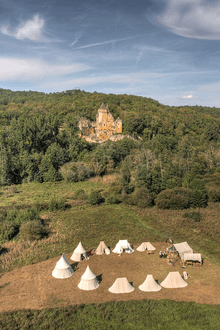Company of Saynt George
The Company of St. George is a living-history group portraying an artillery Company in the age of Charles the Bold (1467-1477).[1][2] The group does events with a civil and military aspect and is known for its display of daily life in a medieval camp.[3]
| Company of St. George | |
|---|---|
| Founded | 1988 |
| Location | Europe, based in Switzerland |
| Period | 1460-1490 |
| Speciality | Daily life |
| Number of members | around 100 |
| Alliances | none |
| Website | www |

Name
There is no correct spelling for the name of the company. The group uses multiple styles on its website: The Company of Saynte George, The Company of Saynt George, The Companie of Saynt George and The Compagnie of Saynte George.[4]All variants seem to be equally correct.
History
The Company of St. George was formed during the 1980s around Gerry Embleton and a group of history enthusiasts living in Switzerland.[5] Traditionally the Company has retained a close link to other groups in the United Kingdom.[6] The Company of St. George has been made popular with the book "The Medieval Soldier", written by Gerry Embleton and John Howe, featuring over one hundred colour photographs of people in historical costume.[6] It has been translated into French, German and Italian. The book came out in 1994 and had an influence on living-history and reenactment. This is especially true on the European continent where it helped to make living history a popular hobby and the second half of the 15th century one of the most popular periods for re-enactment.
Membership[6]
There are around one hundred people involved with the group and about sixty of them are considered active.[2] The active members live in Switzerland, United Kingdom, France, Italy, Austria, Germany, Belgium, the Netherlands, Czech Republic, Poland, Hungary, Denmark and Sweden. Tolkien illustrator John Howe and the historical illustrator Gerry Embleton are prominent members.
Events
The Company of St. George primarily works with museums and does living-history events in close cooperation with them. The ties with the Château du Haut-Kœnigsbourg are particularly strong. There are also private events.
References
- Moore, Tim (2008). I believe in yesterday. London: Jonathan Cape. p. 89f. ISBN 9780224077811. OCLC 233787873. eBook also available: I believe in yesterday. London: Vintage. 2009. ISBN 9781407021034. OCLC 891774184.
- Hafner, Urs (2007-11-15). "Zurück in die Kindheit | NZZ". Neue Zürcher Zeitung (in German). Retrieved 2018-01-22.
- "Die grossen Ritterspiele zu Schaffhausen - Miroque". www.miroque.de (in German). 2014-06-16. Retrieved 2018-01-22.
- "The Company of Saynt George". www.companie-of-st-george.ch. Retrieved 2018-01-22.
- The Company of Saynt George. Miroque. 2011, Iss. 4, p. 121.
- Udo Brühe. Ein buntes Bild der Vergangenheit. A-Faktor, June 2011, Iss. 2, p. 19